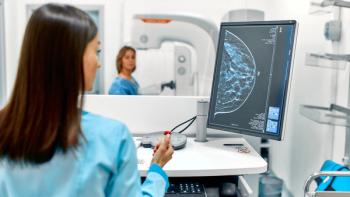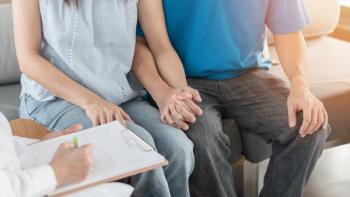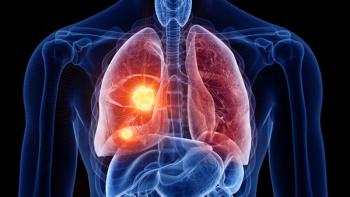
Investigators Seek to Evaluate Obe-Cel’s Role in Relapsed/Refractory B-Cell ALL

An expert with Moffitt Cancer Center comments on the ongoing FELIX trial, and the potential of the novel CAR T-cell therapy, obecabtagene autoleucel, to change the B-cell acute lymphoblastic leukemia treatment paradigm.
The ongoing phase 1/2 FELIX trial (NCT04404660) will assess the safety and efficacy of the CD19-targeted CAR T-cell therapy obecabtagene autoleucel (obe-cel; previously referred to as AUTO1) as a treatment option for adults with relapsed or refractory B-cell acute lymphoblastic leukemia (B-ALL).1
“With obe-cel, [investigators] tried to develop a low-affinity CD19 binder that would allow the CAR T cells to rapidly bind and then release,” Bijal Shah, MD, MS, explained. “The hope was this would do 2 things. The first was that it would decrease [some of] the toxicity associated with CAR T-cell therapy, specifically cytokine release syndrome [CRS] and neurologic adverse effects. [The second is that it] would improve the health of the T cell and limit T-cell exhaustion so now the T cells can stay active for a longer period.”
Previously, in the multicenter phase 1 ALLCAR19 trial (NCT02935257), 20 adult patients with relapsed/refractory B-ALL were infused with obe-cel as part of a split-dose schedule, titrated to pre-lymphodepletion bone marrow disease burden.2 Those with blasts of greater than 20% received 10 x 106 CAR T cells, and those with blasts that were 20% or less received 100 x 106 CAR T cells. At an interval of 9 days, if CRS and immune effecter cell–associated neurotoxicity syndrome (ICANS) was not observed, dose 2 was administered to a total dose of 410 x 106 CAR T cells.
Eighty-five percent of the patients achieved a minimal residual disease (MRD)–negative complete response (CR) at month 1, and 3 of these 17 patients underwent allogeneic stem cell transplantation while in remission. Moreover, the 6-month event-free survival (EFS) rate with the product was 68.3% (95% CI, 42.4%-84.4%); at 12 months, this rate was 48.3% (95% CI, 23.1%-69.7%).
The FELIX trial, which is currently recruiting, will further explore the autologous product in this patient population.1 To be eligible for enrollment, patients will need to be at least 18 years of age, have an ECOG performance status of 0 or 1, documented CD19 positivity within 1 month of screening, and acceptable renal, hepatic, pulmonary, cardiac function.
After preconditioning with a chemotherapy regimen comprised of cyclophosphamide and fludarabine, participants will be given a total target dose of 410 x 106 CD19-positive CAR T cells as a split dose on day 1 and day 10 plus or minus 2 days. The primary objectives are to examine the frequency and severity of adverse effects (AEs) and serious AEs following infusion and to evaluate the overall response rate with the product. Secondary end points include duration of response, progression-free survival, overall survival, and safety, among others.
In an interview with Oncology Nursing News®, Shah, associate member of the Department of Malignant Hematology at Moffitt Cancer Center, shed light on advances made with CAR T-cell therapies in adult patients with B-ALL, the promise of obe-cel as an emerging option, and the key objectives of the recently launched FELIX trial.
Oncology Nursing News®: Could you discuss the evolution of CAR T-cell therapy in ALL treatment? Where does obe-cel fit into the mix? How does it differ from other available products?
Shah: We have 2 approved CAR T-cell products for B-cell ALL. We have tisagenlecleucel [Kymriah], which has been approved for use in children and young adults up to the age of 25 years. More recently, we [saw] the approval of brexucabtagene autoleucel [Tecartus] for all adult patients with relapsed or refractory B-ALL. The setting for the approvals differs a little bit. Tisagenlecleucel was approved [for use] after 2 prior lines of therapy, or after failure or intolerance of a second-generation TKI. The approval for brexucabtagene autoleucel was for any stage of relapse. Patients in first relapse could also be eligible for CAR T-cell [therapy], based on the FDA approval.
We are seeing new CAR T-cell approaches move into multicenter testing, with the goal of FDA approval. The obe-cel product is one that merits some discussion. When we talk about tisagenlecleucel and brexucabtagene autoleucel, we [see] a high-affinity CD19 binder. With obe-cel, [investigators] tried to develop a low-affinity CD19 binder that would allow the CAR T cells to rapidly bind and then release.
[The agent] has been tested in the phase 1 ALLCAR19 study, [which was] recently presented by Claire Roddie, MD, PhD, of the University College of London Hospitals NHS Foundation Trust, [and published] in the Journal of Clinical Oncology. [Data] demonstrated that [the agent] was highly effective. The CR rate was about 85%, and these were MRD negative by [flow cytometry].
The challenge [with this] is going to be twofold: relapse overall, but in particular, CD19-negative relapses. At this point, we are left to speculate why we see this phenomenon. Although we did see this with CD28-based CAR T-cell therapy, the rates seemed to be somewhat [lower]. Preclinical data suggest that for 4-1BB–associated signaling, which is part of the co-stimulatory domain for obe-cel and tisagenlecleucel, these cells may be less sensitive to low CD19 antigen burden on the leukemic blasts. This may allow for the escape of low antigen burden or evolution toward CD19-negative status.
Taking a deeper dive into obe-cel, could you discuss the FELIX trial? What makes this research unique?
FELIX is a phase 1/2 multicenter international trial that is examining [this] low-affinity CAR T-cell product in patients with relapsed and refractory B-cell ALL. What really distinguishes [this trial from others] is the inclusion of a MRD cohort. This is important [because] we have multiple studies and retrospective observations supporting the idea that the best outcomes in terms of response, response duration, and toxicity are associated with a low, and ideally undetectable, disease burden. This is what came out of the pediatric real-world CAR T consortium that Liora M. Schultz, MD, of Stanford University, and colleagues, recently published in the Journal of Clinical Oncology. However, even getting that disease burden to less than 5% seems to be very important in helping to improve outcomes in the context of CAR T-cell therapy.
To some degree, this was unexpected. Although we know that T-cell exhaustion, which can occur when there is high tumor cell burden, could limit the impact of CAR T-cell therapy, the expectation was that even with higher blast burdens, we would not see that play out with the degree of expansion and the other things we see with CAR T-cell therapy. [Conversely], there was a concern that there would not be enough antigen to drive the CAR T cells to grow and kill if we put them into this low MRD setting. However, none of that has borne out. We can see that the CAR T cells remain highly active—even with very low disease burdens. You can draw your cutoff almost anywhere—5%, 10%, 50%—with these 4-1BB–based CAR T-cell therapies, and you start to see a drop-off in response.
When we look at CD28-based CAR T, such as the recently approved brexucabtagene autoleucel, the cutoff may be a little higher. We did not see a drop off in response rate until we got to more than 75% blast. However, it will be interesting to see with longer-term follow-up how these different blast-burden thresholds impact the duration of response. One of the unique things [we saw with] the phase 1/2 ZUMA-3 trial [NCT02614066], which is reflective of an older adult cohort, was the low rate of allogeneic stem cell transplant. We will get a cleaner signature, in terms of durability response, looking across these different blast-cutoff thresholds. FELIX is unique in allowing [those with] low blast burden to enroll.
The other thing that distinguishes the FELIX trial is [that it is utilizing] fractionated infusion. We saw some of this data come from Frey and colleagues when they were using tisagenlecleucel in adult patients. They would give the CAR T-cell product on day 1, day 2, and day 3, but the dose would be fractionated so that if [the patients] experienced severe CRS before the second or third day, they would not receive the full dose of the product. This was to improve safety, particularly as they went up on the total cell dose. They did succeed in that regard, and this set the stage for other approaches looking at fractionated infusion.
[Patients] will receive a dose on day 1, [which will depend] on whether they are coming onto [the trial] with MRD vs more than 20% blasts. For those who have higher blast burden, they will receive a lower starting dose. However, at day 10, provided that any CRS that has occurred has resolved, they will go on to receive a higher cell dose. That is [an important] approach in terms of dosing of the CAR T to try to mitigate toxicity, but also to improve the total dose of cells infused, which may be especially important when we talk about the 4-1BB–based products.
What data have been reported thus far with obe-cel?
Roddie and colleagues published [data from the phase 1 ALLCAR19 trial in the Journal of Clinical Oncology. They enrolled 25 patients and treated 20. Of those who were treated, 17 achieved an MRD-negative remission. An 85% CR [rate] with MRD negativity is outstanding. That is a good signal already.
What they are seeing with follow-up is that many of these responses are maintained. The EFS looks like it is going to be about 1 year [based on the] curves, and that is outstanding; it is a signal for an effective CAR T-cell product. The CAR T cells also seem to persist over time, which seems to be encouraging in terms of helping to mitigate against subsequent relapse. We need to prove that, but the early data are certainly promising.
What should be known about the safety of obe-cel that has been observed to date?
They did see lower toxicity than we are accustomed to seeing with CAR T-cell therapy in adults. CRS and ICANS were not commonly observed, and when they were seen, they seemed to occur more often in those patients who had higher tumor burden going into the CAR T-cell therapy, as we have seen in other trials. Particularly for those patients who are enrolled with very low tumor burden, so less than 5% blasts, the [safety] outcomes were quite good.
These are encouraging data. We are seeing a signal for CD19 antigen loss on the lymphoblasts. This may be a feature of 4-1BB–based CARs, or all CARs. We know that whether it is 4-1BB or CD28, thrombocytosis can occur. There may be other mechanisms in terms of CD19 antigen downregulation, or the ability of these CAR T cells to ferret out low CD19 antigen–bearing blasts, that may also impact this phenotype of CD19-antigen negativity. However, this is something that we will have to follow and contend with.
Therefore, it is important that we also have the evolution of other CAR T-cell therapies occurring in the background, such as the [ones targeting] CD22, and I am sure there are others [under exploration] in B-cell ALL. That may help us initially to manage the CD19-negative relapses, but hopefully at some point, we consider how we can combine our therapies to prevent any relapse from occurring, and [potentially] avoiding this phenomenon altogether.
What other research efforts are generating excitement?
We are seeing the development of humanized CAR T-cell agents, as well as an evolution in CD22-based CAR T-cell therapy. For example, Noelle V. Frey, MD, of Penn Medicine, [recently] presented [data] from a phase 1 trial [NCT03620058] that combined a humanized CD19 CAR T-cell product with CD22-targeted CAR T in patients who had relapsed after prior CAR T-cell therapy. [This approach had] intriguing efficacy. You get what you expect in terms of early CD19 CAR T-cell peak, but as the CD19 CAR T cells faded, you see this second peak of the CD22 CAR T cells. [We need to learn more about] what is driving that CD22 CAR T-cell expansion…and try to put that whole picture together [to have better understand what to expect] post–CAR T-cell therapy. We still have a lot to learn in that space.
I am excited to see how some of these novel approaches are further developed. Data out of Memorial Sloan Kettering Cancer Center, suggest that taking this CD28-based CAR with a CD19 target and then combining it with a CD22-based CAR with a 4-1BB co-stimulatory domain may be the optimal recipe for clearing the leukemic blasts and [may have] that activity to avoid antigen escape. These kinds of approaches where we mix and match our CARs are what I am keeping a close eye on, because there may be some real opportunities to improve outcomes for our patients.
References
- A study of CD19 targeted CAR T cell therapy in adult patients with relapsed or refractory B cell acute lymphoblastic leukaemia (ALL). ClinicalTrials.gov. Updated January 5, 2022. Accessed February 8, 2022.
https://clinicaltrials.gov/ct2/show/NCT04404660 - Roddie C, Dias J, O’Reilly MA, et al. Durable responses and low toxicity after fast off-rate CD19 chimeric antigen receptor-t therapy in adults with relapsed or refractory B-cell acute lymphoblastic leukemia. J Clin Oncol. 2021;39(30):3352-3363. doi:10.1200/JCO.21.00917
Newsletter
Knowledge is power. Don’t miss the most recent breakthroughs in cancer care.




